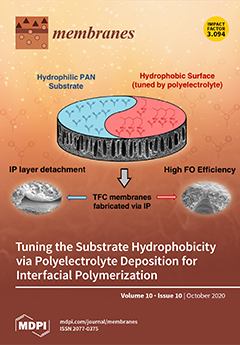Graphdiyne (GDY), with uniform pores and atomic thickness, is attracting widespread attention for application in H
2 separation in recent years. However, the challenge lies in the rational design of GDYs for fast and selective H
2 permeation. By MD and DFT calculations,
[...] Read more.
Graphdiyne (GDY), with uniform pores and atomic thickness, is attracting widespread attention for application in H
2 separation in recent years. However, the challenge lies in the rational design of GDYs for fast and selective H
2 permeation. By MD and DFT calculations, several flexible GDYs were constructed to investigate the permeation properties of four pure gas (H
2, N
2, CO
2, and CH
4) and three equimolar binary mixtures (H
2/N
2, H
2/CO
2, and H
2/CH
4) in this study. When the pore size is smaller than 2.1 Å, the GDYs acted as an exceptional filter for H
2 with an approximately infinite H
2 selectivity. Beyond the size-sieving effect, in the separation process of binary mixtures, the blocking effect arising from the strong gas–membrane interaction was proven to greatly impede H
2 permeation. After understanding the mechanism, the H
2 permeance of the mixtures of H
2/CO
2 was further increased to 2.84 × 10
5 GPU by reducing the blocking effect with the addition of a tiny amount of surface charges, without sacrificing the selectivity. This theoretical study provides an additional atomic understanding of H
2 permeation crossing GDYs, indicating that the GDY membrane could be a potential candidate for H
2 purification.
Full article


